Yii - Query Builder
Query builder allows you to create SQL queries in a programmatic way. Query builder helps you write more readable SQL-related code.
To use query builder, you should follow these steps −
- Build an yii\db\Query object.
- Execute a query method.
To build an yii\db\Query object, you should call different query builder functions to define different parts of an SQL query.
Step 1 − To show a typical usage of the query builder, modify the actionTestDb method this way.
public function actionTestDb() {
//generates "SELECT id, name, email FROM user WHERE name = 'User10';"
$user = (new \yii\db\Query())
->select(['id', 'name', 'email'])
->from('user')
->where(['name' => 'User10'])
->one();
var_dump($user);
}
Step 2 − Go to http://localhost:8080/index.php?r=site/test-db, you will see the following output.

Where() function
The where() function defines the WHERE fragment of a query. To specify a WHERE condition, you can use three formats.
string format − 'name = User10'
hash format − ['name' => 'User10', 'email => user10@gmail.com']
operator format − ['like', 'name', 'User']
Example of String format
public function actionTestDb() {
$user = (new \yii\db\Query())
->select(['id', 'name', 'email'])
->from('user')
->where('name = :name', [':name' => 'User11'])
->one();
var_dump($user);
}
Following will be the output.
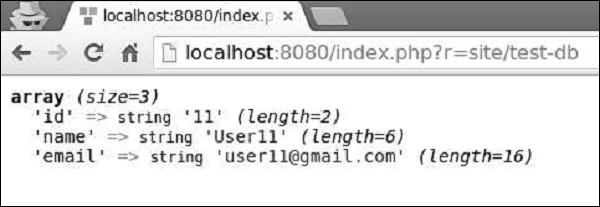
Example of Hash format
public function actionTestDb() {
$user = (new \yii\db\Query())
->select(['id', 'name', 'email'])
->from('user')
->where([
'name' => 'User5',
'email' => 'user5@gmail.com'
])
->one();
var_dump($user);
}
Following will be the output.
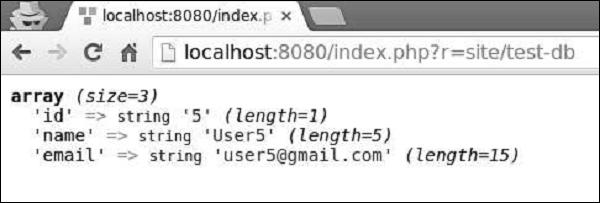
Operator format allows you to define arbitrary conditions in the following format −
[operator, operand1, operand2]
The operator can be −
and − ['and', 'id = 1', 'id = 2'] will generate id = 1 AND id = 2 or: similar to the and
operator
between − ['between', 'id', 1, 15] will generate id BETWEEN 1 AND 15
not between − similar to the between operator, but BETWEEN is replaced with NOT BETWEEN
in − ['in', 'id', [5,10,15]] will generate id IN (5,10,15)
not in − similar to the in operator, but IN is replaced with NOT IN
like − ['like', 'name', 'user'] will generate name LIKE '%user%'
or like − similar to the like operator, but OR is used to split the LIKE predicates
not like − similar to the like operator, but LIKE is replaced with NOT LIKE
or not like − similar to the not like operator, but OR is used to concatenate the NOT LIKE predicates
exists − requires one operand which must be an instance of the yii\db\Query
class
not exists − similar to the exists operator, but builds a NOT EXISTS (subquery) expression
<, <=, >, >=, or any other DB operator: ['<', 'id', 10] will generate id<10
Example of Operator format
public function actionTestDb() {
$users = (new \yii\db\Query())
->select(['id', 'name', 'email'])
->from('user')
->where(['between', 'id', 5, 7])
->all();
var_dump($users);
}
Following will be the output.
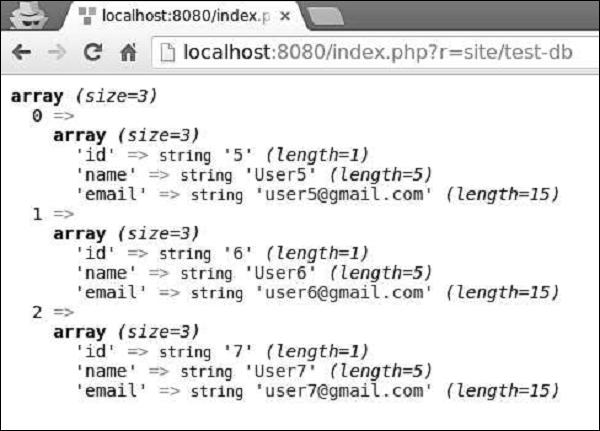
OrderBy() Function
The orderBy() function defines the ORDER BY fragment.
Example −
public function actionTestDb() {
$users = (new \yii\db\Query())
->select(['id', 'name', 'email'])
->from('user')
->orderBy('name DESC')
->all();
var_dump($users);
}
Following will be the output.
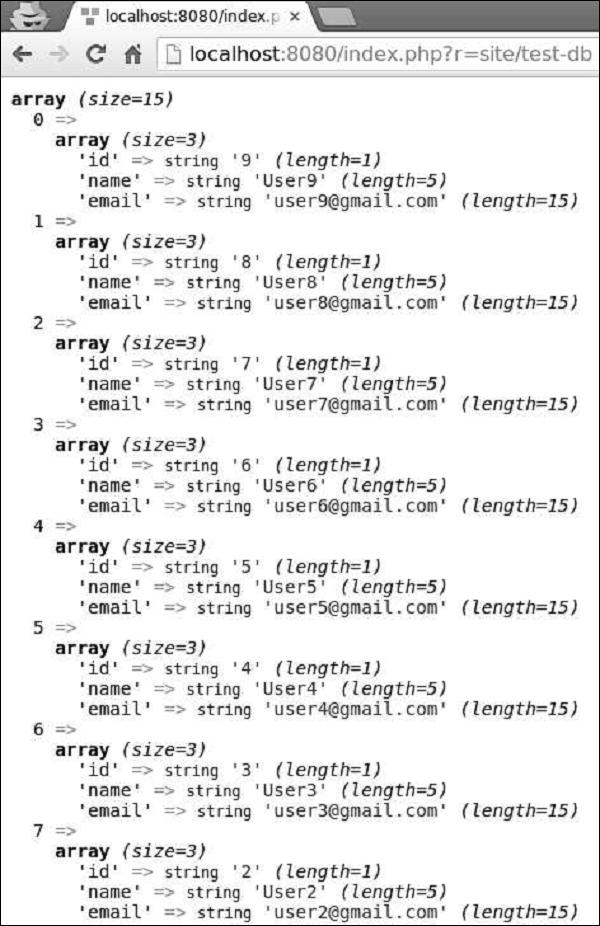
groupBy() Function
The groupBy() function defines the GROUP BY fragment, while the having() method specifies the HAVING fragment.
Example −
public function actionTestDb() {
$users = (new \yii\db\Query())
->select(['id', 'name', 'email'])
->from('user')
->groupBy('name')
->having('id < 5')
->all();
var_dump($users);
}
Following will be the output.

The limit() and offset() methods defines the LIMIT and OFFSET fragments.
Example −
public function actionTestDb() {
$users = (new \yii\db\Query())
->select(['id', 'name', 'email'])
->from('user')
->limit(5)
->offset(5)
->all();
var_dump($users);
}
You can see the following output −
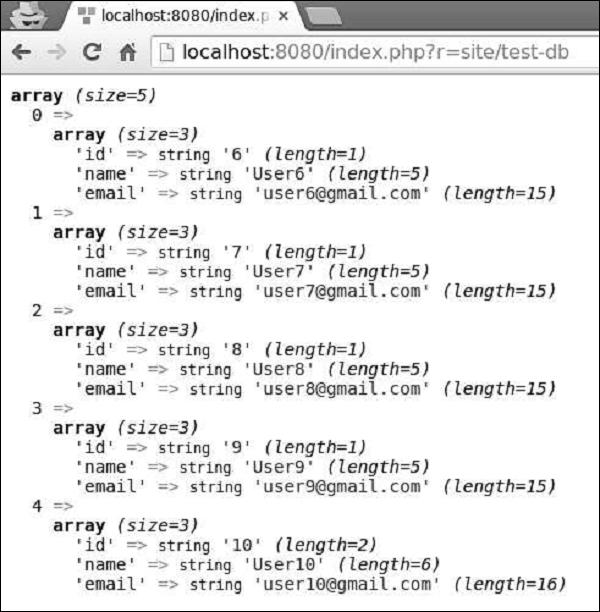
The yii\db\Query class provides a set of methods for different purposes −
all() − Returns an array of rows of name-value pairs.
one() − Returns the first row.
column() − Returns the first column.
scalar() − Returns a scalar value from the first row and first column of the result.
exists() − Returns a value indicating whether the query contains any result
count() Returns the result of a COUNT query
other aggregation query methods − Includes sum($q), average($q), max($q), min($q). The $q parameter can be either a column name or a DB expression.









